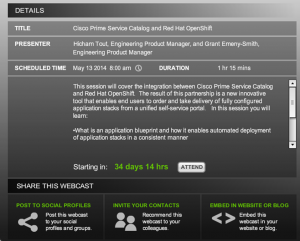































In previous blogs I have described how organizations are maturing beyond provisioning of individual servers to provisioning of richer cloud-based application stacks. Known as platform-as-a-service (PaaS), this capability takes cloud technology beyond infrastructure to automate the application life cycle. PaaS allows developers and IT operations to collaborate and ensure that application stacks are consistent and delivered to your customers - within minutes.
Last summer at CiscoLive Orlando, the Application Stack Accelerator for Cisco Intelligent Automation for Cloud (IAC) was introduced and we quickly noticed that PaaS was an extremely popular topic! This popularity has grown. The demand for PaaS is heavy as organizations, probably like yours, look to extend cloud automation to the design, configuration and implementation of the application life cycle.
Some benefits you can achieve with PaaS include:
In January, as part of the CiscoLive Milan announcement, a stronger partnership between Cisco and Red Hat was announced with several key initiatives being launched to extend OpenStack and enable open, interoperable cloud environments. One of the initiatives mentioned in this announcement was a PaaS offering designed to allow customers to manage both legacy and web-scale cloud environments. The first fruit of this PaaS initiative is a Cisco Validated Design (CVD) reference architecture that combines Cisco Prime Service Catalog with the Red Hat OpenShift platform. This reference architecture delivers dynamic scaling, tenant-level security as well as integrated management and provisioning to your applications.
Cisco values the benefits of PaaS and has extended this CVD into a new cloud accelerator for Cisco IAC, clearing the way for developers and IT operations to more easily deploy applications. Cisco Prime Service Catalog is a key component to Cisco IAC providing an end-user self-service portal that allows your customers to consume and manage their applications along with their other cloud-based services. The auto-scaling capability of OpenShift ensures that infrastructure resources are dynamically increased, without operator intervention, safeguarding against any impact to your applications when resource thresholds are achieved.
Attending Red Hat Summit next week? Then be sure to stop by the Cisco (Booth#611) or Red Hat (Booth#211) for a demo on our new cloud accelerator. Or better yet, attend our two breakout sessions:
Tuesday, April 15th Cisco Prime Service Catalog and Red Hat OpenShift
10:40 am
Tuesday, April 15th Quantifying the Financial Benefits of PaaS
3:40 pm
Go here to discover all that Cisco will be doing at Red Hat Summit.

Can't attend Red Hat Summit? Then join us on May 13th for a live webinar on the integration between Cisco Prime Service Catalog and Red Hat OpenShift. You can register for this event here.
PaaS technology lets your organization deliver applications with higher quality, availability and consistency. Cisco Prime Service Catalog and Red Hat OpenShift let you implement PaaS technology on an open source platform delivering a win for developers, IT operations and consumers of your applications.
 Tags chauds:
Logiciel libre
devops
Gestion du Cloud
cloud automation
paas
IAC
red hat
application acceleration
Red Hat Summit
Tags chauds:
Logiciel libre
devops
Gestion du Cloud
cloud automation
paas
IAC
red hat
application acceleration
Red Hat Summit